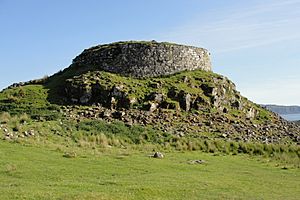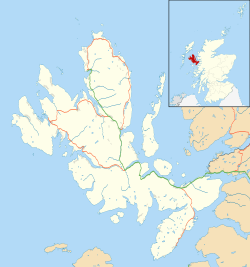Dun Beag facts for kids

Dun Beag
|
|
| Location | Skye |
|---|---|
| Coordinates | 57°21′37″N 6°25′33″W / 57.360355°N 6.425767°W |
| Type | Broch |
| History | |
| Periods | Iron Age |
| Site notes | |
| Ownership | Historic Environment Scotland |
| Public access | Yes |
Dun Beag is a very old stone tower, known as a broch. It was built during the Iron Age, a time when people started using iron tools. This ancient site is found on the west coast of the Isle of Skye in Scotland. It sits about 1 kilometer northwest of a small village called Struan.
Contents
What is Dun Beag?
Dun Beag is a special type of ancient building called a broch. Brochs are round, drystone towers. They were built by people living in Scotland during the Iron Age. Dun Beag is located on a small, rocky hill.
The tower itself is about 18.6 meters across. Its walls are very thick, about 4 meters wide at the bottom. Today, the walls still stand up to 2 meters high.
Inside, the tower is about 11 meters wide. The main entrance faces east. If you look closely at the inner wall, you can see three openings.
- One opening leads to a small room inside the wall.
- Another opening goes into a long, narrow passage built within the wall.
- The third opening leads to a stone staircase. About twenty steps of this old staircase are still there!
A Look Back in Time: Dun Beag's History
Dun Beag has been standing for a very long time. It has seen many changes over the centuries.
Famous Visitors
In 1772, a traveler named Thomas Pennant visited the broch. He wrote that it was still quite tall, perhaps 4 meters high. Just one year later, in 1773, two other famous visitors came to the area. They were Samuel Johnson, a well-known writer, and James Boswell, his friend. They were on a trip called their Tour to the Hebrides. They likely visited Dun Beag, which was near a place called Ullinish. Since their visit, about half of the broch's original height has been lost.
Digging Up the Past
Between 1914 and 1920, a woman named Countess Vincent Baillet de Latour led an excavation at Dun Beag. This means archaeologists carefully dug up the site to learn more about it. They removed about 200 tons of earth and stones from the broch. Every bit of soil was carefully checked by hand!
During the excavation, many interesting objects were found. These included:
- Tools and dishes made of stone.
- A gold ring and other items made of bronze.
- A piece of folded lead.
- Objects made of iron and glass.
- A tool made from bone for boring holes.
- A pick made from an animal's antler.
- Many pieces of pottery.
- A stone cup.
Hundreds of glass beads were also discovered. However, experts don't think these beads are from the prehistoric Iron Age. They might have been left there much later.
Coins from different kings were also found at Dun Beag. These include coins from Henry II, Edward I, James VI, George II, and George III. Finding these coins suggests that people might have continued to use the broch, or at least visited it, until more recent times.


